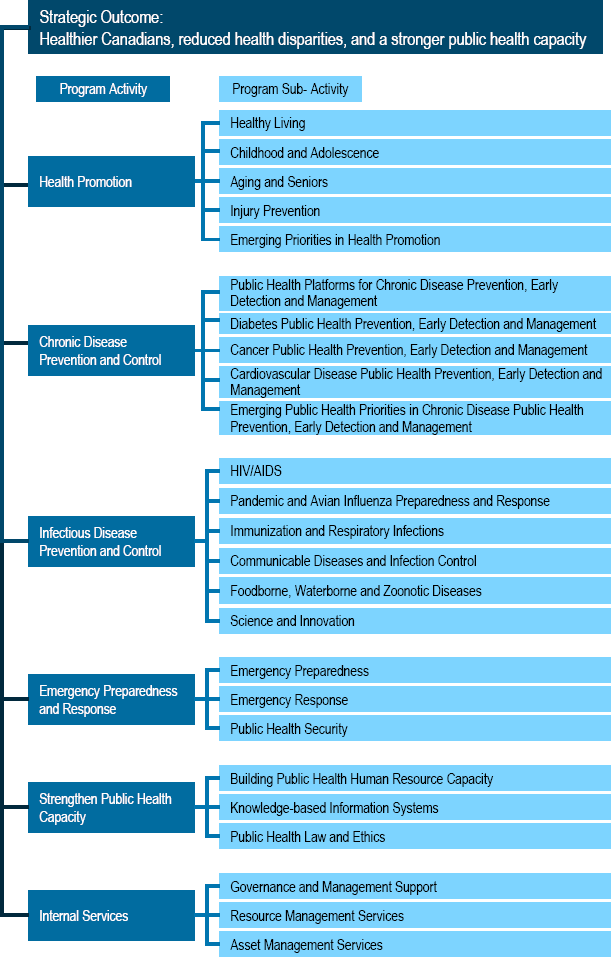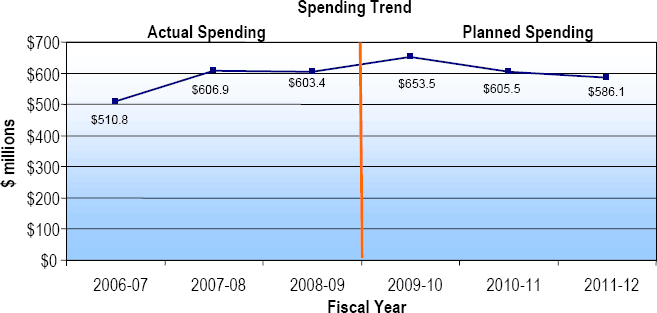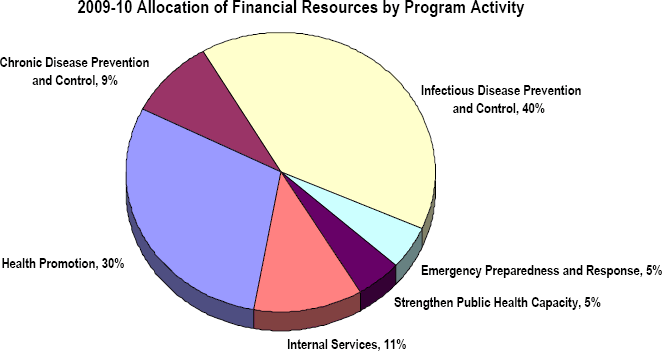Common menu bar links
Breadcrumb Trail
ARCHIVED - Public Health Agency of Canada
 This page has been archived.
This page has been archived.
Archived Content
Information identified as archived on the Web is for reference, research or recordkeeping purposes. It has not been altered or updated after the date of archiving. Web pages that are archived on the Web are not subject to the Government of Canada Web Standards. As per the Communications Policy of the Government of Canada, you can request alternate formats on the "Contact Us" page.
Minister’s Message
 I am pleased to present the 2009-2010 Report on Plans and Priorities for the Public Health Agency of Canada. The Agency plays a vital role in the promotion and protection of the health of Canadians.
I am pleased to present the 2009-2010 Report on Plans and Priorities for the Public Health Agency of Canada. The Agency plays a vital role in the promotion and protection of the health of Canadians.
By working to prevent illness and injury, the Agency enhances the Government of Canada’s ability to keep Canadians and their families healthy. With a focus on prevention, the Agency partners across sectors and jurisdictions to promote good health practices and to help eliminate barriers to healthy behaviours. One way it does this is by delivering new and ongoing public health information programs. These include activities such as the healthy pregnancy initiative, partnering on the World Health Organization’s groundbreaking Age-Friendly Cities Guide, and updating Canada’s Physical Activity Guides with versions for children, youth, adults and seniors.
Governments, community groups, all sectors of society, and individuals all have a role to play in helping Canadians achieve and maintain good health. The Agency will continue to work across Canada to support projects to promote physical activity and healthy eating as well partnering with other major health stakeholders.
The Agency is also working to protect the health of Canadians by strengthening Canada’s emergency preparedness, including planning for pandemic influenza. While we cannot always predict the timing of emergencies and pandemics, we can be as prepared as possible. Through the Agency’s work, and supported by its surveillance systems, nationwide quarantine service and effective emergency response protocols, we are in a better position than ever to protect Canadians and respond to outbreaks of infectious disease and foodborne illness, as well as other emergencies that impact human health.
The Agency has close to 2500 dedicated professionals delivering its programs across the country. I have every confidence in their ability to focus on the priorities outlined in this report. The Agency will be reporting on the progress against this plan in the Agency’s 2009-2010 Departmental Performance Report.
The Honourable Leona Aglukkaq
Minister of Health
Government of Canada
Message from the Chief Public Health Officer
 Created in 2004, the Public Health Agency of Canada has made real progress in strengthening public health in Canada.
Created in 2004, the Public Health Agency of Canada has made real progress in strengthening public health in Canada.
This is in large part due to how we have brought a collection of programs, activities and expectations together into an effective and unified federal entity charged with protecting and promoting public health.
Today, there is a clear recognition of the importance of public health activities to the overall well-being of a country, and of the valuable role played by the Public Health Agency in improving and protecting the health of Canadians.
While emergency preparedness and response is a key responsibility, the Agency addresses the totality of the population’s health. We protect against and respond to outbreaks and emergencies, but we also strive to prevent the basic things that kill and disable Canadians every day. We work with our many partners to reduce inequalities in health between groups of people, and to foster those conditions that give all Canadians, of all ages, backgrounds and socio-economic status, the opportunity to be healthy.
In the coming year, the Agency will continue to face its challenges and embrace opportunities to strengthen Canada’s preparedness for emergencies and disasters, and to deliver on strategies and programs for the prevention of infectious disease, the promotion of health, and the prevention and control of chronic disease and injury. The Agency will undertake all of these activities while we deliver on the whole of our mandate in a strategic, coordinated and accountable fashion.
Dr. David Butler-Jones, M.D.
Chief Public Health Officer
Section I – Overview
1.1 Summary Information
Raison d’être
Public health involves the organized efforts of society to keep people healthy and to prevent injury, illness and premature death. It is a combination of programs, services and policies that protect and promote the health of all Canadians. In Canada, public health is a responsibility that is shared by the three levels of government, the private sector, non-government organizations, health professionals and the public.
In September 2004, the Public
Health Agency of Canada (Agency) was created within the federal ![]() Health Portfolio to
deliver on the Government of Canada’s commitment to help protect the health and safety of all Canadians and to increase its focus on public health, and to contribute to improving health and strengthening the health care system. Its activities focus on preventing and controlling chronic and infectious diseases, preventing injuries and preparing for and responding to public health
emergencies.
Health Portfolio to
deliver on the Government of Canada’s commitment to help protect the health and safety of all Canadians and to increase its focus on public health, and to contribute to improving health and strengthening the health care system. Its activities focus on preventing and controlling chronic and infectious diseases, preventing injuries and preparing for and responding to public health
emergencies.
Responsibilities
The Agency has the responsibility to:
- contribute to the prevention of disease and injury, and the promotion of health;
- provide federal leadership and accountability in managing public health emergencies;
- serve as a central point for sharing Canada’s expertise with the rest of the world and applying international research and development to Canada’s public health programs; and
- strengthen intergovernmental collaboration on public health and facilitate national approaches to public health policy and planning.
In December 2006, the Public Health Agency of Canada Act came into force, giving the Agency the statutory basis to continue fulfilling these roles.
Program Activity Architecture
In order to effectively pursue its mandate, the Agency aims to achieve a single strategic outcome supported by its Program Activity Architecture depicted in the following figure.

1.2 Planning Summary
| 2009-10 | 2010-11 | 2011-12 |
|---|---|---|
| $ 653.5 | $ 605.5 | $ 586.1 |
| 2009-10 | 2010-11 | 2011-12 |
|---|---|---|
| 2,434.9 | 2,446.5 | 2,445.1 |
* Full-Time Equivalents are calculated based on days worked, in order to properly include persons employed for part of the year and/or employed part-time.
| Performance Indicators and Targets |
|---|
| The Agency is currently redeveloping its Management, Resources and Results Structure including Strategic Outcome performance indicators and targets. |
| Program Activity | Expected Results | Forecast Spending 2008-09 |
Planned Spending | Alignment to Government of Canada Outcomes | ||
|---|---|---|---|---|---|---|
| 2009-10 | 2010-11 | 2011-12 | ||||
| Health Promotion | Increased awareness and knowledge of health and well being, the factors that influence these, and how they can play a role in improving and maintaining their health and that of their families and communities. | 198.2 | 194.5 | 191.3 | 191.5 |  Healthy Canadians Healthy Canadians |
| Chronic Disease Prevention and Control | Access to science-based, authoritative and timely information and tools to support informed decision-making on preventing chronic diseases and decreasing health risks. | 61.1 | 60.3 | 60.4 | 60.4 |  Healthy Canadians Healthy Canadians |
| Infectious Disease Prevention and Control | Reduced incidence of infectious diseases of public health importance in Canada and improved response to infectious disease outbreaks in Canada both in the health care and community settings. | 183.9 | 261.3 | 214.9 | 193.3 |  Healthy Canadians Healthy Canadians |
| Emergency Preparedness and Response | Canada is prepared to respond to public health risks caused by natural and human caused emergencies and recover from the aftermath of these emergencies. | 45.3 | 32.3 | 31.2 | 32.0 |  Safe and Secure Communities Safe and Secure Communities |
| Strengthen Public Health Capacity | Canada has the public health workforce, information, laws and ethical frameworks needed to meet Canada’s public health needs. | 32.9 | 31.1 | 31.2 | 33.0 |  Healthy Canadians Healthy Canadians |
| Internal Services | 82.0 | 74.0 | 76.5 | 75.9 | n/a | |
| Total Planned Spending | 603.4 | 653.5 | 605.5 | 586.1 | ||
Contribution of Priorities to the Strategic Outcome
| Priorities (Type) | Description |
|---|---|
| Enhance Surveillance (New) | Surveillance integrates information on the health of the population and supports knowledge functions to guide effective responses to emerging issues and public health challenges. As one of the core functions of public health, surveillance also provides the building blocks to support the other major functions of the Agency: population health assessment, disease and injury prevention, health promotion, health protection, and emergency preparedness and response. A multi-disciplinary working group reviewed surveillance activities within the Agency and identified a strategy that will guide the organization from a wide variety of processes, people and technologies into a coherent approach. |
| Disease prevention and control (Ongoing) | The federal government, in conjunction with provincial, territorial and local governments, plays a key role in reducing the threat of infectious diseases. With two in five Canadians suffering from chronic diseases, and four in five at risk, the Agency also plays a key role in preventing the major chronic diseases facing Canadians, including diabetes, heart, lung and neurological diseases. The Agency mobilizes stakeholders at all levels to support the development of guidelines, standards, policies, programmes and public health interventions for health promotion and disease prevention in Canada and internationally. |
| Review of the federal approach to immunization, with a view of strengthening the National Immunization Strategy (New) | Immunization programs have had a major impact on the health of the population, as many diseases are prevented through immunization. These programs resulted in substantial savings to the health system and improvements in length and quality of life. In Canada, immunization is a shared responsibility between federal, provincial and territorial governments. The National Immunization Strategy outlined a coherent, collaborative, progressive strategy to meet the immunization needs of all Canadians. The Agency is undertaking a review of the federal approach to immunization, in collaboration with provinces and territories, in order to continue to strengthen immunization in Canada. |
| Emergency preparedness for disease outbreaks including pandemic influenza (Ongoing) | The impact of an uncontrolled outbreak of any infectious disease would be serious. Domestically and globally, there are significant concerns related to pandemic influenza and emerging infections. Domestic and international health factors require a comprehensive and highly collaborative approach to disaster preparedness. The Agency takes a proactive “all hazards” approach to emergency management, working with emergency preparedness and response partners and stakeholders across Canada to prepare for and respond to natural and human-caused health emergencies at anytime, anywhere across the country. Emergency preparedness includes the development of emergency operations plans, processes, ongoing training and exercises, planning tools and technologies that support improved interoperability and response capabilities during emergencies. |
| Transformation of Grants and Contributions (New) | Grants and Contributions (G&Cs) are an important instruments uses in the delivery of the Agency’s programs. Work is underway to improve the way G&C are used to cause transformational change in public health. |
Risk Analysis
Global Economy
Economic uncertainty has and will continue to be a major risk factor for governments world-wide and the unanimous focus for all governments will be action to restore confidence in the markets and revive the economy. The economic downturn poses a number of health-related risks including the creation of newly-vulnerable groups as unemployment rates rise and economic growth slows The Agency will consider the impact of the economic downturn on the health and well-being of Canadians in its activities to mitigate the risk.
Population
Demographic shifts are changing Canada’s population make-up. Canada’s population growth is disproportionately in groups currently identified as more vulnerable to health risks, including Aboriginal people. Other shifts, such as aging and urbanization, also change public health needs. The Agency will consider these changing demographics in its public health activities and interventions, including its efforts to reduce health disparities.
Innovative approaches to understanding, assessing and addressing non-medical determinants of health are being developed in collaboration with domestic and international partners. These approaches will inform more effective interventions to reduce health disparities borne by Canada’s vulnerable populations including First Nations, Inuit and Metis people, children, seniors, and people living in rural and remote areas.
Climate Change
Climatic variations are projected to have adverse impacts on public health and safety. Although many health effects of climate change have been identified, the disease burden for only a limited number of climate-sensitive diseases has been quantified. The knowledge gained by identifying and quantifying the ways in which climate change can affect health may be used to improve the design and effectiveness of preventive measures.
Science and Technology
The rate of scientific discovery and technological innovation has increased dramatically in the past decade. By providing new approaches for improving health and preventing disease, these innovations can mitigate pressures on the health system. For example, advances in public health genomics – an emerging field that assesses the impact of the interaction between genes and the environment on population health – lead to discoveries that can be applied to prevent disease and improve the health of Canadians. This context offers both risks and opportunities for the Agency, as government science is challenged to keep up with, and lead scientific advances and translate them into health applications and associated policy.
Partners and Stakeholders
The Agency depends greatly on a broad range of partners and stakeholders to achieve positive long-term results for Canadians. The Agency takes a complementary and collaborative approach to improve the likelihood of successful outcomes. For example, it engages stakeholders through national-level bodies to develop and achieve consensus on standards, develop surveillance systems, and identify best practices; and it facilitates coordinated action to address national priorities and focus scarce public health resources. The Agency’s Regional Offices play an important role in connecting and working with partners and stakeholders on a variety of files. It is essential that the Agency’s activities and those of its partners and stakeholders align to achieve results and outcomes of program delivery.
Expenditure Profile
The Agency’s forecast spending for 2008-09 is $603.4 million, as shown in the chart below, Spending Trend. The decrease in planned spending from 2009-2010 to 2010-2011 is mainly due to the requirement to pay $49.7 million in 2009-10 to the provinces under the Hepatitis C Health Care Services Program. This program has been providing funding to the provinces every five years as compensation for the care of individuals infected with Hepatitis C. The final payments will occur in 2014-15. In addition, spending associated with the Aboriginal Head Start in Urban and Northern Communities program has been reduced in 2010-2011 to account for the sunsetting of incremental funding provided to the program in Budget 2005 ($4.9M). Offsetting these decreases, the Agency will receive funding for two items announced in Budget 2008, Environmental Contaminants and Consumer and Food Products ($2.3M) and incremental funding ($2.2M) for the implementation of the legislation on Human Pathogens. Other small technical adjustments account for the difference ($2.1M).
The decrease of $19.4 million from 2010-2011 to 2011-2012 is mainly due to a reduction resulting from the phased funding approach for the Canadian HIV Vaccine Initiative ($8.2M) and a reduction for the planned sunsetting of the Clean Air Agenda ($2.5M) and anticipated incremental funding for Human Pathogens legislation ($1.0M). Other small technical adjustments account for the difference ($9.7M).
| Vote or Statutory Item* | Truncated Vote or Statutory Wording | 2009-10 Main Estimates ($ millions) |
2008-09 Main Estimates ($ millions) |
|---|---|---|---|
| 40 | Operating expenditures | 352.7 | 360.5 |
| 45 | Capital expenditures | 9.6 | 0.0 |
| 50 | Grants and Contributions | 255.4 | 199.6 |
| (S) | Contributions to employee benefit plans | 30.3 | 30.4 |
| Total - Agency | 648.0 | 590.5 | |
*Vote numbers pending Treasury Board Secretariat approval.
The decrease of $7.8 million in Vote 40 between the 2008-2009 and the 2009-2010 Main Estimates is mainly attributable to a realignment of capital expenditures under a separate vote, and reduced funding for Preparedness for Avian and Pandemic Influenza. These decreases are offset by increased funding for Health, Consumers and Food Products and the 2010 Vancouver Winter Olympics.
The increase of $9.6 million in Vote 45 between the 2008-2009 and the 2009-2010 Main Estimates is attributable to the establishment of a new vote for capital expenditures related to the refit of the Ward (Logan) Laboratory Project in Winnipeg and other equipment purchases for the Agency.
The increase of $55.8 million in Vote 50 includes $49.7 million to be paid to the provinces under the Hepatitis C Health Care Services Program.


